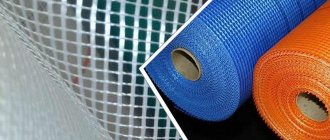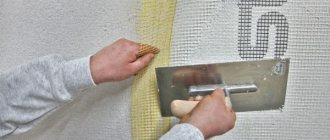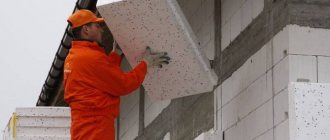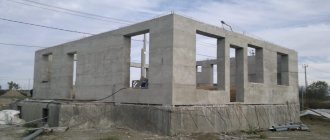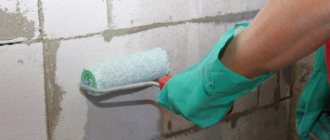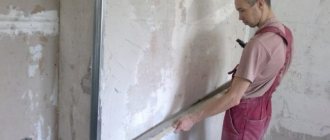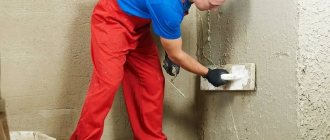- 1 General information
- 2 Nuances and subtleties
- 3 Tools needed
- 4 Work technology 4.1 Wall preparation
- 4.2 Preparation of materials
- 4.3 Wallpapering
Before you start hanging wallpaper, you need to determine what style the room will be. Today, the choice of wall coverings is huge; the main thing is to take into account all the nuances and choose the appropriate roll. People often wonder: is it possible to cover concrete walls? The answer is clear - you can! But before you start work, you need to carry out all the preparatory stages, and then a positive result will not be long in coming.
Features of concrete walls
Speaking about the features of concrete walls, let’s remember what kind of houses are built from concrete. These are panel and skyscrapers. If your house is made of panels, then the walls are made of concrete.
Walls made of this material have the following features:
- Concrete walls are dark or light gray in color. It will appear on the wallpaper if you do not finish the wall surface.
- They have irregularities. Although they are invisible at first glance, they will be very clearly visible on the wallpaper.
- Concrete walls have a grainy consistency, which will also be very visible on the wallpaper.
To avoid this, the walls must be treated with primer and putty.
What wallpaper can be glued to concrete without finishing?
Theoretically, wallpaper can be pasted without special preparation, but the results of such work can be very far from ideal.
If you skip the stages of plastering and putty, the surface must be properly primed to improve adhesion between the surface and the canvas. Most suitable for gluing to unprepared concrete are thin paper wallpapers that are not monochromatic, as they can visually hide unevenness. Vinyl, non-woven bases, as well as materials for painting will not adhere to an unprepared surface, therefore, in order to avoid repeated work and unnecessary material costs, you should not use them in such cases.
How to prepare the base
As we can see, if you put wallpaper on a concrete wall without preliminary finishing, at first it will not look aesthetically pleasing, and then it will disappear altogether. Therefore, before repairing walls by wallpapering, you need to prepare the surface. How to do it. There are different options. The use of plaster, putty, also primer, including concrete contact.
Plaster. It can be purchased at a hardware or hardware store. Before applying plaster, treat the wall with a primer. Then apply the first layer of plaster. They need to smooth out all the bumps and potholes. When it dries, apply a second one - finishing. After this, apply the primer again. and then you can glue the wallpaper.
Putty. She can smooth out all the imperfections well. Also great as a finishing coat.
If you don’t have the desire or ability to bother with plaster and putty, you can simply prime it before gluing. Clean the wall from dust. Irregularities still need to be sealed with putty. After it dries, apply primer to the wall. After it dries, it is worth applying a second layer. When the second one dries, you can glue the wallpaper.
Stage two: primer
After completing the first stage, the preparation of the walls continues with their primer. It is needed to fasten the surface layer of the wall, penetrating deeply into the plaster or concrete. The wall surface begins to absorb moisture worse, which improves the quality of its coating. In addition, the primer removes dust, cleaning the surface. It must be remembered that the preparation of concrete at each stage must be accompanied by priming.
The primer is applied using a roller or brush until a white foam forms. If it absorbs quickly, additional layers are applied. After the primer has dried, the wall is rough leveled.
Concrete contact
This is one of the types of primer, the peculiarity of which is the presence of quartz sand in its composition. In addition, there are special products that do not react to alkalis. They increase the adhesion of the material and make it very durable. All this makes this type of primer very effective.
Before gluing wallpaper on concrete, purchase this primer. Use it to fill in any uneven spots. Then apply it to the entire wall. When it dries, wallpaper can be applied to concrete walls.
Let's start gluing
You can begin finishing the premises if the conditions are met. Work is not carried out at temperatures below +5 degrees. The optimal indicator is +15 degrees. Neglect of this rule will result in the canvases ending up inside a cold room.
It is necessary to exclude drafts - close doors and windows.
Even after the work is completed, they wait 10 hours. During this time, the adhesive will adhere quite firmly.
Choosing glue
It is purchased according to the type of wallpaper purchased. There are many varieties of universal compounds, but craftsmen do not recommend their use - what is good for paper is bad for vinyl or non-woven material and vice versa.
You need to take a separate mixture for non-woven, paper, vinyl, liquid or other types of coating.
There is also a choice - to take a dry mixture or a ready-made solution. Here you need to focus on work preferences and the overall budget for finishing work. There is a coating with an adhesive layer on the reverse side. To paste it, just remove the protective layer from the back side, place the sheet in the desired place, press tightly, and smooth it out.
What tool will you need?
To work, you will need a plumb line, a building level, a tape measure, a simple pencil, scissors or a stationery knife.
For the glue you need a free container, clean water, a wide brush, and a paint roller.
Smooth the sheet with a plastic spatula, rubber roller or wide brush.
It is important to quickly remove excess adhesive with a clean cloth.
We purchase and prepare material
The number of rolls must be calculated with a margin. You can look at the official websites of construction stores to see the length of one roll and its width to get an answer to your question.
You can measure it with a roll of old wallpaper, apply it to the wall, and walk around the entire room, counting the number of “steps.” All that remains is to calculate the quantity based on the average size of one sheet.
Cutting blanks involves measuring each sheet separately, if we are talking about a pattern with a fit, or cutting off the first piece as a guide - then the rest can be cut according to it.
If the ceilings/floors are uneven, you will need to measure each piece. For this you need a tape measure. This increases the risk of error or each time you have to stand on a stepladder, apply the blade, and actually cut it off.
You will need to leave a margin of 1-2 cm, which can then be easily cut off or hidden behind the baseboard. The main thing is that there is enough length.
Technology of work execution
The cut sheet is covered with glue diluted according to the manufacturer's instructions on the reverse side. You need to wait the time indicated on the wallpaper packaging for the canvas to soak.
The next step is to lift the workpiece by the upper corners, bring it to the top of the base, and press it tightly.
Now you need to take a plastic spatula or rubber roller and secure the top of the sheet.
The process of wallpapering walls
The first segment must be glued plumb, to prevent the line from bending.
Afterwards, with a smoothing tool, movements are made from the center to the edges at an angle, according to the herringbone principle. This removes air bubbles.
If this is not done carefully enough, the air will cause the canvas to bubble. Sometimes a simple puncture with a needle does not help.
The next sheet is glued end-to-end or overlapping with the first.
Substrate application
Another way to prepare the surface is to stick old newspapers on the walls. This will save time and money. Moreover, it is very easy to do. The disadvantages of this finish are that with constant humidity and dampness, mold may appear. That is, this method is only suitable for well-heated rooms. Another disadvantage is that when thin wallpaper is hung, the contents of newspapers may be displayed on it.
Sticking newspapers to a concrete wall is easy. You just need to smear them with glue and stick them on the wall. Then they should dry well, and only then can you glue the wallpaper onto the concrete.
Choosing a new coating
When choosing decorative products, be guided by the following criteria:
- Condition of the walls in the room. If there are defects in the base, it is advisable to purchase dense, two-layer products with a relief front surface and an applied pattern that will help visually hide the unevenness.
- To decorate a room of a non-standard shape, with various niches, recesses, avoid decorative material with a large pattern - such canvases look beautiful in large rooms (how to calculate the amount of wallpaper per room?).
- Wear resistance and resistance to fading under the influence of ultraviolet radiation. If you are going to renovate a room with high traffic, a suitable option would be canvases that can be washed and painted (what kind of wallpaper is suitable for painting?). For a room where the sun's rays constantly fall on the walls, choose wallpaper with a protective layer against ultraviolet radiation.
If the windows in the room face south, materials in cold or dark, rich colors will help create a cool atmosphere. And vice versa: orange, beige, apricot, coffee shades will visually make a house with windows facing north “warmer” (how to choose the right wallpaper color?).
Try to purchase rolls from the same batch to eliminate possible material discrepancies in color.
Leveling with putty
As we have already said, concrete walls have cracks and irregularities that must be repaired before wallpapering the concrete walls. Putty will do a good job of this.
It should work like this:
- Prime first. The primer will fill cracks, provide protection against mold, and also serve as an excellent adhesive.
- After the first coat has completely dried, apply a second coat of primer.
- After the second layer has dried, apply putty, leveling the walls with it. The first layer should be thicker.
- When the first layer of putty has dried, you can apply the second. It should be thinner.
- After the second layer has completely dried, you need to apply the primer again, and when it dries, you can glue the wallpaper onto the concrete.
Learn how to putty walls in the video below:
Nuances and subtleties
Before you start gluing the canvas, take into account some of the subtleties and nuances of the material used and the technology of its application. The key to further success is a properly prepared surface, which must be perfectly flat and carefully processed. To do this, the surface is puttied and primed.
It is important to properly prepare the adhesive base and cut the wallpaper according to the design.
An important step is the correct preparation of the adhesive base. Be sure to follow the instructions on the package and let the prepared solution stand for 20-30 minutes. To prevent spreading, you need to pay attention to the joints in the corners, which must be correctly laid out and taped. When cutting a roll, pay attention to the pattern and design, which should match when joined. Such wall decor should be carried out without drafts in the room, otherwise it will lead to the appearance of bubbles, delamination and spreading of the joints.
Not all wallpaper coverings have the same application technology. For example, when working with non-woven wallpaper, you should not apply glue directly to the wall with concrete and to the back side of the canvas - this leads to lagging and stretching of the material. Before starting work, thoroughly study the instructions and features of the materials used.
Return to contents
